|
Some of the Union ships involved in the bombardment of Fort
Fisher Courtesy of Richard Edling, Philadelphia, PA |
|
USS Kansas
USS Wabash
USS Vicksburg
USS New Ironsides
USS Canonicus
USS Saugus
USS Mahopac USS Gettysburg USS Quaker City USS Monticello USS Alabama USS Vanderbilt USS Fort Jackson USS Rhode Island USS Montgomery USS Keystone State USS Iosco USS Monadnock USS Huron USS Sassacus USS Mackinaw USS Ticonderoga USS R.R. Cuyler USS Santiago de Cuba USS Maratanza |
|
USS Kansas (1863-1883) Top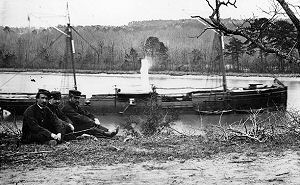 USS Kansas, first of a class of 836-ton screw steam
gunboats, was built at the Philadelphia Navy Yard, Pennsylvania.
Commissioned in December 1863, she was assigned to the North Atlantic
Blockading Squadron for operations in North Carolina and Virginia waters.
While off New Inlet, North Carolina, on 6 May 1864, Kansas saw
combat against the Confederate ironclad ram Raleigh. Later in the
month, she captured the blockade running steamer Tristam Shandy,
and in October and December 1864 participated capturing the blockade
runner Annie and destroying the Stormy Petrel. Kansas
took part in the abortive attempt to capture Fort Fisher in late December
and the successful effort the next month. USS Kansas, first of a class of 836-ton screw steam
gunboats, was built at the Philadelphia Navy Yard, Pennsylvania.
Commissioned in December 1863, she was assigned to the North Atlantic
Blockading Squadron for operations in North Carolina and Virginia waters.
While off New Inlet, North Carolina, on 6 May 1864, Kansas saw
combat against the Confederate ironclad ram Raleigh. Later in the
month, she captured the blockade running steamer Tristam Shandy,
and in October and December 1864 participated capturing the blockade
runner Annie and destroying the Stormy Petrel. Kansas
took part in the abortive attempt to capture Fort Fisher in late December
and the successful effort the next month.
USS Wabash (1856-1912) Top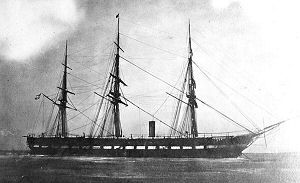 USS Wabash, a 4808-ton steam screw frigate, was built at
the Philadelphia Navy Yard. Commissioned in August 1856, she initially
served as flagship of the Home Squadron, then went to the Mediterranean in
1858-59. During 1861, the Civil War's first year, Wabash blockaded
the Confederacy's Atlantic Coast and participated in the captures of
Hatteras Inlet, North Carolina, and Port Royal, South Carolina. As
flagship of the South Atlantic Blockading Squadron, she was an active
force in the Blockade of Charleston, S.C., in 1862-64. Her Civil War
service was climaxed by participation in the ultimately successful
December 1864 and January 1865 assaults on Fort Fisher, North Carolina. USS Wabash, a 4808-ton steam screw frigate, was built at
the Philadelphia Navy Yard. Commissioned in August 1856, she initially
served as flagship of the Home Squadron, then went to the Mediterranean in
1858-59. During 1861, the Civil War's first year, Wabash blockaded
the Confederacy's Atlantic Coast and participated in the captures of
Hatteras Inlet, North Carolina, and Port Royal, South Carolina. As
flagship of the South Atlantic Blockading Squadron, she was an active
force in the Blockade of Charleston, S.C., in 1862-64. Her Civil War
service was climaxed by participation in the ultimately successful
December 1864 and January 1865 assaults on Fort Fisher, North Carolina.
Inactivated in February 1865, Wabash recommissioned in 1871 and served for two years as flagship of the Mediterranean Squadron. In 1876, she became the receiving ship at the Boston Navy Yard, Massachusetts. Ultimately housed over to increase internal space, Wabash served in this role until she was sold in November 1912. The following year, she was burned to facilitate salvage of her metal parts. USS Vicksburg (1863-1865 ) Top USS Vicksburg, an 886-ton (burden) screw steam gunboat,
was built in 1863 at Mystic, Connecticut, for civilian use. The Navy
purchased the new steamer in October 1863 and, after conversion for
warlike purposes, placed her in commission in early December. Her first
assignment was inspection duty in and near New York Harbor, an action
prompted by Confederate agents' seizure of the steamship
Chesapeake on 7 December 1863.
In February 1864 Vicksburg began service with the North Atlantic
Blockading Squadron off the Carolina coast. She captured a sailing
blockade runner in late April and, during the rest of the year, chased
several steamers that were attempting to trade with the Confederacy. USS Vicksburg, an 886-ton (burden) screw steam gunboat,
was built in 1863 at Mystic, Connecticut, for civilian use. The Navy
purchased the new steamer in October 1863 and, after conversion for
warlike purposes, placed her in commission in early December. Her first
assignment was inspection duty in and near New York Harbor, an action
prompted by Confederate agents' seizure of the steamship
Chesapeake on 7 December 1863.
In February 1864 Vicksburg began service with the North Atlantic
Blockading Squadron off the Carolina coast. She captured a sailing
blockade runner in late April and, during the rest of the year, chased
several steamers that were attempting to trade with the Confederacy.
In addition to her blockade work, in mid-July 1864 Vicksburg was briefly stationed off Annapolis, Maryland, to defend against a possible enemy attack. During the year's final week she took part in the unsuccessful attempt to capture Fort Fisher, North Carolina, and in January 1865 was part of the combined operation that took that powerful fortification. On 11 February, Vicksburg helped bombard Half Moon Battery, one of the remaining enemy positions near Fort Fisher. Soon afterwards, she was sent to the James River, Virginia, to support the Army's campaign to break through the defenses of Richmond. USS Vicksburg was decommissioned in late April, shortly after the Confederacy's collapse. She was sold to private owners in July 1865 and was employed as a merchant vessel until about 1868. USS New Ironsides (1862-1866) Top USS New Ironsides, a 4120-ton broadside ironclad, was
built at Philadelphia, Pennsylvania. The last, and largest, of the initial
group of three "salt-water" armored warships begun in 1861 in response to
meet the needs of the Civil War, she was commissioned in August 1862.
Following a lengthy fitting-out period, she joined the South Atlantic
Blockading Squadron in January 1863. For the next year, she operated in
support of the blockade of Charleston, South Carolina, and took part in
several attacks on the Confederate fortifications defending that city.
New Ironsides's heavy broadside battery of eight heavy guns on each
side, coupled with her iron protection, made her a uniquely valuable ship
for bombardment purposes. USS New Ironsides, a 4120-ton broadside ironclad, was
built at Philadelphia, Pennsylvania. The last, and largest, of the initial
group of three "salt-water" armored warships begun in 1861 in response to
meet the needs of the Civil War, she was commissioned in August 1862.
Following a lengthy fitting-out period, she joined the South Atlantic
Blockading Squadron in January 1863. For the next year, she operated in
support of the blockade of Charleston, South Carolina, and took part in
several attacks on the Confederate fortifications defending that city.
New Ironsides's heavy broadside battery of eight heavy guns on each
side, coupled with her iron protection, made her a uniquely valuable ship
for bombardment purposes.
The first of these actions took place on 7 April 1863, when nine Federal ironclads entered Charleston harbor and conducted a prolonged, though inclusive, bombardment of Fort Sumter. New Ironsides was repeatedly hit by enemy cannon fire, but was not seriously damaged, unlike several of her consorts. During the summer of 1863, the ship battered Confederate positions during the successful campaign to take Fort Wagner. During this effort, on 21 August, New Ironsides was the target of a torpedo boat attack attack. Another such attack, by CSS David during the night of 5 October 1863, damaged the ironclad, but she was able to remain on station until May 1864, when she went to Philadelphia for repairs and a general overhaul. Upon completion of this work in late August, New Ironsides recommissioned to join the North Atlantic Blockading Squadron. In December she participated in a major assault on Fort Fisher, North Carolina, in an effort to stop blockade running into the port of Wilmington. Though this attack was called off on Christmas Day, after an extensive bombardment, the Federal fleet returned to renew the operation in mid-January 1865. New Ironsides was one of dozens of warships that vigorously shelled Fort Fisher, preparing the way for a ground assault that captured the position on 15 January. For the next few months, New Ironsides supported Union activities in the Hampton Roads area. She decommissioned in April 1865 and was laid up at Philadelphia. There, on 16 December 1866, USS New Ironsides was accidently destroyed by fire. USS Canonicus (1864-1908) Top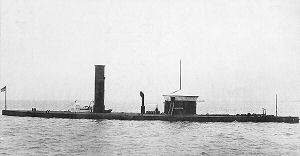 USS Canonicus, name ship of a class of nine 2100-ton
monitors, was built at Boston, Massachusetts. Commissioned in April 1864,
she served in the James River area of Virginia from May 1864 until late in
the year, taking part in engagements with Confederate batteries on 21
June, 16 August and 5-6 December. On 24-25 December 1864, Canonicus
helped bombard Fort Fisher, on the North Carolina coast, in an abortive
attempt to capture that vital enemy strongpoint. Returning to the scene in
mid-January, she was part of a large fleet that relentlessly shelled the
fort, preparing the way for a successful ground assault that took the
position. This operation closed the port of Wilmington to further blockade
running and markedly hastened the collapse of the Confederacy. USS Canonicus, name ship of a class of nine 2100-ton
monitors, was built at Boston, Massachusetts. Commissioned in April 1864,
she served in the James River area of Virginia from May 1864 until late in
the year, taking part in engagements with Confederate batteries on 21
June, 16 August and 5-6 December. On 24-25 December 1864, Canonicus
helped bombard Fort Fisher, on the North Carolina coast, in an abortive
attempt to capture that vital enemy strongpoint. Returning to the scene in
mid-January, she was part of a large fleet that relentlessly shelled the
fort, preparing the way for a successful ground assault that took the
position. This operation closed the port of Wilmington to further blockade
running and markedly hastened the collapse of the Confederacy.
For the rest of the Civil War, Canonicus was mainly stationed off Charleston, South Carolina, though toward the end of the conflict she made a voyage to Havana, Cuba, in search of the Confederate ironclad Stonewall. The monitor was decommissioned in late June 1865. While in reserve, she was renamed Scylla for less than two months in June-August 1869 before regaining her original name. Canonicus returned to commissioned status for Atlantic coast and Gulf of Mexico cruises from 1872 until 1877, when she was laid up for the last time. Though she saw no further active service, the old ironclad was towed to Hampton Roads, Virginia, in mid-1907 for exhibit during the Jamestown Exposition. The last survivor of the Navy's once-large fleet of Civil War monitors, she was sold for scrapping the next year. USS Saugus (1864-1891) Top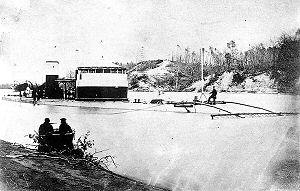 USS Saugus, a 2100-ton Canonicus class monitor,
was built at Wilmington, Delaware. Commissioned in April 1864, she served
in the North Atlantic Blockading Squadron during the Civil War's final
year, primarily in the James River region. The ship engaged Confederate
batteries and ironclads in Trent's Reach, on the James, on 21 June 1864
and fired on the enemy on other occasions during the next several months.
In late December, she went to sea to participate in the abortive attempt
to capture Fort Fisher, on the North Carolina coast. A few weeks later,
Saugus returned for the bombardment and amphibious operation that took
that vital strong point on 15 January 1865, thus closing the port of
Wilmington to blockade runners. After a few months' further duty on the
James, she went to the Washington Navy Yard, D.C., in early April and was
temporarily used there as a prison for suspected conspirators in the
murder of President Abraham Lincoln. USS Saugus, a 2100-ton Canonicus class monitor,
was built at Wilmington, Delaware. Commissioned in April 1864, she served
in the North Atlantic Blockading Squadron during the Civil War's final
year, primarily in the James River region. The ship engaged Confederate
batteries and ironclads in Trent's Reach, on the James, on 21 June 1864
and fired on the enemy on other occasions during the next several months.
In late December, she went to sea to participate in the abortive attempt
to capture Fort Fisher, on the North Carolina coast. A few weeks later,
Saugus returned for the bombardment and amphibious operation that took
that vital strong point on 15 January 1865, thus closing the port of
Wilmington to blockade runners. After a few months' further duty on the
James, she went to the Washington Navy Yard, D.C., in early April and was
temporarily used there as a prison for suspected conspirators in the
murder of President Abraham Lincoln.
Saugus was out of commission at the Washington Navy Yard between June 1865 and April 1869. She then served along the Florida coast and at Key West until the end of 1870. In June 1869, she was briefly renamed Centaur, but regained her original name in August. Saugus was again in commission for duty along the Atlantic and Gulf coasts during most of the 1872-77 period. She was sold in May 1891. USS Mahopac (1864-1902) Top USS Mahopac, a 2100-ton Canonicus class monitor
built at Jersey City, New Jersey, was commissioned in September 1864.
During the latter part of 1864, she mainly served on the James River,
where she engaged a Confederate battery at Howlett's Farm on 5-6 December.
Later in that month, she steamed down the North Carolina coast to take
part in the initial attempt to capture Fort Fisher and thus close off
blockade running into the port of Wilmington. That effort failed, but
Mahopac returned on 13-15 January 1865 with a large Federal fleet and
land force that overwhelmed the powerful fortification. USS Mahopac, a 2100-ton Canonicus class monitor
built at Jersey City, New Jersey, was commissioned in September 1864.
During the latter part of 1864, she mainly served on the James River,
where she engaged a Confederate battery at Howlett's Farm on 5-6 December.
Later in that month, she steamed down the North Carolina coast to take
part in the initial attempt to capture Fort Fisher and thus close off
blockade running into the port of Wilmington. That effort failed, but
Mahopac returned on 13-15 January 1865 with a large Federal fleet and
land force that overwhelmed the powerful fortification.
After spending a few months off Charleston, South Carolina, Mahopac returned to the James River area, where she assisted in the capture of Richmond in April 1865. With the Civil War at an end, she was out of commission at Washington, D.C., in 1865-66. Returning to active duty in the latter year, Mahopac served along the east coast for more than a decade, including some time in decommissioned status. She was renamed Castor in June 1869 but regained her original name less than two months later. The monitor was kept in the James River vicinity, possibly including some time on active service, during 1877-1895. USS Mahopac was then laid up at Philadelphia'a League Island Navy Yard until March 1902, when she was sold. USS Gettysburg (1864-1879) Top The 726-ton (burden) iron side-wheel steamship Douglas
was built at Glasgow, Scotland, in 1858 for employment as an Isle of Man
packet. Purchased by Confederate interests in November 1862, she soon
began a remarkable career as a blockade runner. Douglas arrived at
Charleston, South Carolina, in late January 1863 on her first voyage
through the Federal blockade. She was renamed Margaret and Jessie
shortly afterwards. During the next nine months, she made eight more runs
into Southern ports, five to Charleston and three to Wilmington, North
Carolina. While attempting another passage to Wilmington, she was captured
by USS Nansemond and the U.S. Army transport Fulton on 5
November 1863. The 726-ton (burden) iron side-wheel steamship Douglas
was built at Glasgow, Scotland, in 1858 for employment as an Isle of Man
packet. Purchased by Confederate interests in November 1862, she soon
began a remarkable career as a blockade runner. Douglas arrived at
Charleston, South Carolina, in late January 1863 on her first voyage
through the Federal blockade. She was renamed Margaret and Jessie
shortly afterwards. During the next nine months, she made eight more runs
into Southern ports, five to Charleston and three to Wilmington, North
Carolina. While attempting another passage to Wilmington, she was captured
by USS Nansemond and the U.S. Army transport Fulton on 5
November 1863.
Later in the month, the erstwhile blockade runner was purchased by the U.S. Navy. She was converted to a gunboat and commissioned as USS Gettysburg in early May 1864. Sent back to the scene of her earlier exploits, she now began to enforce the North's blockade of the South and was involved in the capture of three steamers during the rest of the year: Little Ada (9 July), Lilian (24 August) and Armstrong (4 December). Later in December 1864 and in mid-January 1865, Gettysburg took part in the two attacks that finally captured Fort Fisher, guardian of the entrance to the port of Wilmington. In addition to shelling the fort, during the January attack she put ashore a landing party of crewmen, who suffered serious casualties while attempting to force their way into the fortress. Gettysburg subsequently was used as a transport along the Atlantic Coast until decommissioned in June 1865. Gettysburg recommissioned in December 1866 for a brief visit to the Caribbean, but went out of service at the beginning of March 1867. A year later she was reactivated and sent to the Caribbean area to conduct scientific work and protect American interests. She was again out of commission between October 1869 and November 1873. Her next period of active duty included transport duty along the Atlantic coast, punctuated by service in February-May 1874 supporting a survey of possible inter-oceanic canal routes across Central America. Laid up again during April-September 1875, Gettysburg was assigned to carry out navigational surveys in the West Indies during late 1875 and the first several months of 1876. Following shipyard work, in October 1876 she went to the Mediterranean Sea for more survey duty. Gettysburg remained in the "middle sea" for the rest of her Navy career. She was decommissioned and sold at Genoa, Italy, in May 1879. USS Quaker City (1861-1865) Top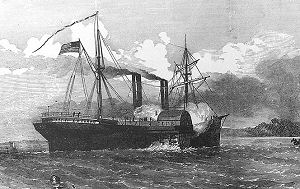 Quaker City, a 1428-ton (burden) wooden side-wheel
steamship, was built at Philadelphia, Pennsylvania, in 1854. She was
chartered by the Navy in April 1861, soon after the outbreak of the Civil
War, and sent to enforce the Federal blockade of the mouth of Chesapeake
Bay. Over the next five months, she captured or took part in the capture
of ten would-be blockade runners. Quaker City, a 1428-ton (burden) wooden side-wheel
steamship, was built at Philadelphia, Pennsylvania, in 1854. She was
chartered by the Navy in April 1861, soon after the outbreak of the Civil
War, and sent to enforce the Federal blockade of the mouth of Chesapeake
Bay. Over the next five months, she captured or took part in the capture
of ten would-be blockade runners.
In August 1861, shortly before Quaker City's charter was to expire, she was purchased for formal conversion into a warship. This work began in Septermber and she was commissioned in December 1861. She was then sent to sea to search for the Confederate cruiser Sumter and was later similarly employed when necessitated by the activities of other Confederate raiders. While she did not encounter any enemy warships on the high seas, on 31 January 1863 she was damaged in a fight with the Southern ironclads Chicora and Palmetto State off Charleston, South Carolina. Quaker City also continued her campaign against blockade runners, participating in the capture of more than a dozen during 1862-1865. In December 1864 and January 1864, she was part of the powerful fleet that supported the capture of Fort Fisher, thus closing Wilmington, North Carolina, to enemy commerce. While serving in the Gulf of Mexico area in May 1865, she assisted in the chase of CSS Webb as that ship made a dramatic run down the Mississippi River in an abortive attempt to escape from the collapsing Confederacy. Decommissioned in May 1865, Quaker City was sold a month later and resumed her commercial career. During a trip to Europe in 1867, she was the scene of some of the tales related by Mark Twain in his book "The Innocents Abroad". The steamer was sold and renamed Columbia in 1869, then, after joining the Haitian Navy in the same year, became Mont Organis�. Sold again in February 1871, she was renamed R�publique, but was lost at sea off Bermuda later in that month. USS Monticello (1861-1865) Top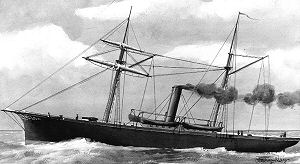 USS Monticello, a 655-ton screw steam gunboat, was built
at Mystic, Connecticut, in 1859 for civilian use. Chartered by the Navy in
May 1861, she was named Star for a few weeks and then reverted to
the name Monticello. She was purchased by the Navy in September
1861. Her Civil War record was a busy one, involving active employment in
the blockade of the Confederacy's Atlantic seacoast and the capture of
several prizes. She took part in early wartime actions in the James River
area of Virginia and in the August 1861 capture of Hatteras Inlet, North
Carolina. USS Monticello, a 655-ton screw steam gunboat, was built
at Mystic, Connecticut, in 1859 for civilian use. Chartered by the Navy in
May 1861, she was named Star for a few weeks and then reverted to
the name Monticello. She was purchased by the Navy in September
1861. Her Civil War record was a busy one, involving active employment in
the blockade of the Confederacy's Atlantic seacoast and the capture of
several prizes. She took part in early wartime actions in the James River
area of Virginia and in the August 1861 capture of Hatteras Inlet, North
Carolina.
In 1863-65, Monticello was commanded by the celebrated naval hero William B. Cushing, and members of her crew were involved in many of his exploits. She accidently rammed and sank the gunboat USS Peterhoff on 6 March 1864. In December 1864 and January 1865, she participated in the attacks on and capture of Fort Fisher, N.C. USS Monticello was decommissioned in July 1865 and sold the following November. She subsequently became the merchant steamer Monticello, and was so employed until she sank off Newfoundland in April 1872. USS Alabama (1861-1865) Top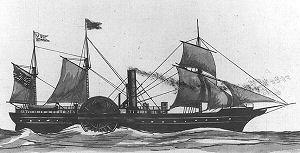 Alabama, a 1261-ton wooden side-wheel steamer, was built
at New York City in 1850 and operated thereafter in commercial service in
the western Atlantic. The U.S. Army used her as a transport during the
spring and early summer of 1861, and she was purchased by the Navy at the
beginning of August of that year for conversion to a warship. Commissioned
as USS Alabama at the end of September 1861, in the next month she
was attached to the large naval force preparing to seize Port Royal, South
Carolina, for use as a base for blockading the southern seacoast. However,
before that expedition reached its target area, she was detached and sent
to patrol off Charleston, South Carolina. In December, Alabama took
station along the Georgia coast, capturing the ship Admiral there
on the 12th. Alabama, a 1261-ton wooden side-wheel steamer, was built
at New York City in 1850 and operated thereafter in commercial service in
the western Atlantic. The U.S. Army used her as a transport during the
spring and early summer of 1861, and she was purchased by the Navy at the
beginning of August of that year for conversion to a warship. Commissioned
as USS Alabama at the end of September 1861, in the next month she
was attached to the large naval force preparing to seize Port Royal, South
Carolina, for use as a base for blockading the southern seacoast. However,
before that expedition reached its target area, she was detached and sent
to patrol off Charleston, South Carolina. In December, Alabama took
station along the Georgia coast, capturing the ship Admiral there
on the 12th.
For the rest of 1861 and most of 1862, Alabama continued to enforce the blockade. In February and March 1862 she took part in the occupation of coastal positions in Georgia and Florida, and later played a role in the capture of at least three blockade running schooners. Alabama was under repair in October-December 1862, after which she spent nearly seven months cruising in the West Indies area in search of Confederate commerce raiders. She was sent north in late July 1863 in an effort to control an outbreak of yellow fever among her crew and did not resume active service until May 1864. Alabama served with the North Atlantic Blockading Squadron for the rest of the Civil War. While off the North Carolina coast in October 1864, she assisted in the destruction of the blockade runner Annie. Late in 1864 and in January 1865, Alabama supported the attacks that finally captured Fort Fisher, thus closing the port of Wilmington, N.C., as a source of supplies and commerce for the Confederate cause. During March and April 1865, she operated in the vicinity of Hampton Roads and on the James River, Virginia. Her final active service was performed cruising along the mid-Atlantic coast. USS Alabama was decommissioned at Philadelphia in mid-June 1865 and sold less than a month later. She soon resumed civilian employment, with no change in name, and remained in merchant service until destroyed by fire in 1878. USS Vanderbilt (1862-1873) Top Vanderbilt, a 3360-ton (burden) wooden side-wheel
steamship, was built in 1856 at Greenpoint, Long Island, New York, for
commercial trans-Atlantic passenger service. The U.S. Army chartered her
for use as a transport soon after the outbreak of the Civil War. In March
1862 she was turned over to the U.S. Navy and converted into a cruiser.
Commissioned as USS Vanderbilt in September 1862, she spent the
last two months of 1862 and all of 1863 searching in the Atlantic Ocean
and West Indies for the Confederate cruiser
Alabama. While this extended cruise did not produce an
encounter with the elusive enemy warship, Vanderbilt did capture
three merchant ships suspected of blockade running or other traffic with
the enemy, including steamer Peterhoff in February 1863; steamer
Gertrude in April; and bark Saxon in October 1863. Vanderbilt, a 3360-ton (burden) wooden side-wheel
steamship, was built in 1856 at Greenpoint, Long Island, New York, for
commercial trans-Atlantic passenger service. The U.S. Army chartered her
for use as a transport soon after the outbreak of the Civil War. In March
1862 she was turned over to the U.S. Navy and converted into a cruiser.
Commissioned as USS Vanderbilt in September 1862, she spent the
last two months of 1862 and all of 1863 searching in the Atlantic Ocean
and West Indies for the Confederate cruiser
Alabama. While this extended cruise did not produce an
encounter with the elusive enemy warship, Vanderbilt did capture
three merchant ships suspected of blockade running or other traffic with
the enemy, including steamer Peterhoff in February 1863; steamer
Gertrude in April; and bark Saxon in October 1863.
Following repairs that occupied much of 1864, Vanderbilt patrolled in the North Atlantic against blockade runners operating out of Halifax, Nova Scotia. She served on the blockade off Wilmington, North Carolina, beginning in November 1864 and took part in the December 1864 and January 1865 attacks on Wilmington's Fort Fisher that finally resulted in closing that port to Confederate commerce. In the spring of 1865, Vanderbilt carried Sailors to the Gulf of Mexico and towed ironclads between East Coast ports. She was used as a receiving ship at the Portsmouth Navy Yard, in Kittery, Maine, during the summer of that year. From November 1865 to June 1866 Vanderbilt voyaged from the U.S. Atlantic Coast around South America, escorting the ironclad Monadnock to San Francisco, California. During October and November 1866 she visited Hawaii, carrying that country's queen home from the U.S. Vanderbilt was laid up at the Mare Island Navy Yard from May 1867 until April 1873, when she was sold to private owners. The ship was subsequently converted to a sailing vessel and renamed Three Brothers. Later in the 19th Century she was used as a coal hulk at Gibraltar and was not broken up until 1929. USS Fort Jackson (1863-1865) Top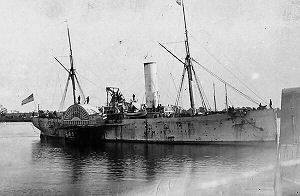 USS Fort Jackson, a 1850-ton (burden) wooden side-wheel
cruiser, was built at New York City in 1862 as the civilian steamship
Union. The U.S. Navy purchased her in July 1863 and, after conversion
to a warship, placed her in commission as USS Fort Jackson in
August of that year. A boiler casualty kept her out of combat service
until late in 1863, when she joined the North Atlantic Blockading
Squadron. During the next year, Fort Jackson worked to enforce the
blockade of the Confederate Atlantic coast. While performing this duty,
she assisted in destroying the blockade runner Bendigo (3 January
1864) and captured the steamers Thistle
(4 June), Boston (8 July) and Wando
(21 October 1864). USS Fort Jackson, a 1850-ton (burden) wooden side-wheel
cruiser, was built at New York City in 1862 as the civilian steamship
Union. The U.S. Navy purchased her in July 1863 and, after conversion
to a warship, placed her in commission as USS Fort Jackson in
August of that year. A boiler casualty kept her out of combat service
until late in 1863, when she joined the North Atlantic Blockading
Squadron. During the next year, Fort Jackson worked to enforce the
blockade of the Confederate Atlantic coast. While performing this duty,
she assisted in destroying the blockade runner Bendigo (3 January
1864) and captured the steamers Thistle
(4 June), Boston (8 July) and Wando
(21 October 1864).
In December 1864 and January 1865, Fort Jackson participated in the operations that finally captured Fort Fisher, North Carolina, thus ending blockade running into the port of Wilmington. She was transferred to the West Gulf Blockading Squadron in February 1865 and served off Texas until after the final surrender of Confederate positions there in June. USS Fort Jackson was decommissioned and sold in August 1865. She subsequently became commercial steamer North America and was not broken up until 1879. USS Rhode Island (1861-1865) Top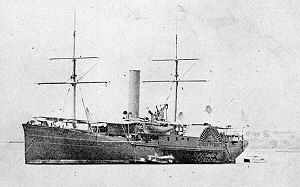 USS Rhode Island, a 1517-ton side-wheel steamer, was the
civilian steamship Eagle when
she was acquired by the Navy in June 1861. Commissioned in late July of
that year, Rhode Island was initially employed as a supply ship,
carrying men and cargo from Northern bases to the units operating along
the Confederate coastline. After service in the Gulf of Mexico, she was
assigned to tow the ironclad USS Monitor
from Hampton Roads, Virginia, south to join the Naval forces in South
Carolina waters. On 30-31 December 1862, after encountering a severe storm
off Cape Hatteras, Monitor was overcome by the weather and sank.
Under very difficult conditions, boats from Rhode Island rescued
most of the lost ship's officers and men. USS Rhode Island, a 1517-ton side-wheel steamer, was the
civilian steamship Eagle when
she was acquired by the Navy in June 1861. Commissioned in late July of
that year, Rhode Island was initially employed as a supply ship,
carrying men and cargo from Northern bases to the units operating along
the Confederate coastline. After service in the Gulf of Mexico, she was
assigned to tow the ironclad USS Monitor
from Hampton Roads, Virginia, south to join the Naval forces in South
Carolina waters. On 30-31 December 1862, after encountering a severe storm
off Cape Hatteras, Monitor was overcome by the weather and sank.
Under very difficult conditions, boats from Rhode Island rescued
most of the lost ship's officers and men.
In early 1863, Rhode Island was sent to the West Indies to look for Confederate cruisers thought to be operating in the area. During the rest of that year and into 1864, she operated along the Atlantic coast. Placed out of commission for repairs in April 1864, Rhode Island returned to active service in early September with a greatly increased gun battery, better suiting her for a cruising role. In addition to serving in that mission, she also towed several monitors to and from the combat zone and participated in the assaults on Fort Fisher, North Carolina, in December 1864 and January 1865. Throughout her Civil War service, Rhode Island took part in the capture or destruction of seven blockade runners. Several months after the end of the conflict, Rhode Island helped bring the former Confederate ironclad Stonewall from Cuba to the U.S. She remained in service through 1866 and beyond, cruising in the western Atlantic and West Indies areas. USS Rhode Island was decommissioned in 1867 and sold in October of that year. She subsequently had a lengthy civilian career under the name Charleston. USS Montgomery (1861-1865) Top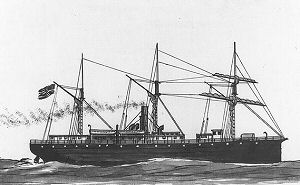 Montgomery, a 787-ton (burden) wooden screw steamship,
was built at New York City in 1858. She was chartered by the Navy in May
1861, soon after the outbreak of the Civil War, and placed in commission
as USS Montgomery. The Navy purchased her in August. During
June-November 1861, she served in the Gulf of Mexico, enforcing the
blockade of western Florida. Later in the year, Montgomery was
shifted to the northern Gulf coast. On 4 December 1861, in Mississippi
Sound, she engaged the Confederate steamers Florida and Pamlico. Montgomery, a 787-ton (burden) wooden screw steamship,
was built at New York City in 1858. She was chartered by the Navy in May
1861, soon after the outbreak of the Civil War, and placed in commission
as USS Montgomery. The Navy purchased her in August. During
June-November 1861, she served in the Gulf of Mexico, enforcing the
blockade of western Florida. Later in the year, Montgomery was
shifted to the northern Gulf coast. On 4 December 1861, in Mississippi
Sound, she engaged the Confederate steamers Florida and Pamlico.
Remaining in the Gulf, during 1862 Montgomery captured or destroyed a half-dozen blockade runners, mainly sailing vessels. Following her return to the Atlantic in 1863, she took part in the search for the Confederate raider Tacony in June. Later assigned to the North Atlantic Blockading Squadron, in January 1864 she helped to destroy the blockade runners Bendigo and Dare. The next month, Montgomery captured the steamer Pet and in October took the Bat. She also participated in the two assaults on Fort Fisher, North Carolina, during December 1864 and January 1865, operations that finally eliminated the nearby city of Wilmington as a blockade running port. For the remainder of the Civil War, Montgomery served along the Carolina coast and participated in operations in North Carolina's Cape Fear River. Decommissioned in June 1865 and sold in August, Montgomery retained her name when she reentered commercial service in 1866. She was active for nearly eleven more years, until she was sunk in a collision off Cape Hatteras, N.C., on 7 January 1877. USS Keystone State (1861-1865) Top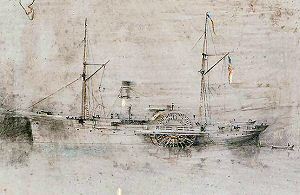 USS Keystone State , a 1364-ton side wheel steamship,
was built at Philadelphia, Pennsylvania, in 1853 as the civilian steamer
Keystone State. Chartered by
the Navy in April 1861, as the Civil War began, she captured one suspected
blockade runner in May. Purchased after the charter period ended, she was
placed in commission a month later. For the rest of that year, Keystone
State cruised in the Atlantic and Caribbean areas. USS Keystone State , a 1364-ton side wheel steamship,
was built at Philadelphia, Pennsylvania, in 1853 as the civilian steamer
Keystone State. Chartered by
the Navy in April 1861, as the Civil War began, she captured one suspected
blockade runner in May. Purchased after the charter period ended, she was
placed in commission a month later. For the rest of that year, Keystone
State cruised in the Atlantic and Caribbean areas.
Operations with the South Atlantic Blockading Squadron began in January 1862, and Keystone State took part the seizure of positions along the Florida and Georga coasts during March 1862. Mainly, however, she patrolled offshore, capturing several blockade runners. While stationed off Charleston, South Carolina, on 31 January 1863, Keystone State was disabled while engaging the Confederate ironclads Chicora and Palmetto State. Repaired locally, she remained in service until June 1863, then went north for an overhaul. Keystone State returned to active duty in October 1863 and served thereafter with the North Atlantic Blockading Squadron, mainly off the North Carolina coast. From November 1863 until September 1864 she took or helped take six more blockade running steamships, assisted in the destruction of another and recovered a large number of cotton bales. She was part of the fleet that assaulted Fort Fisher, North Carolina, in December 1864 and captured it in January 1865. After a few months of additional operations USS Keystone State was decommissioned in March 1865. She was sold in September of that year. USS Iosco (1864-1868) Top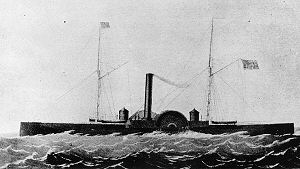 USS Iosco, a 1173-ton Sassacus class
"double-ender" steam gunboat, was built at Bath, Maine. Commissioned in
April 1864, she protected shipping in the Gulf of Saint Lawrence during
the summer and was then sent to join the North Atlantic Blockading
Squadron. While operating off Wilmington, North Carolina, on 21 November,
Iosco captured the blockade runner Sybil. During December
1864 and January 1864, she participated in the assaults on Fort Fisher,
which ultimately closed Wilmington as a Confederate port. In 1865, she was
active on the North Carolina Sounds, taking part in an expedition up the
Roanoke River in mid-May. USS Iosco decommissioned in July 1865 and
in February 1868 was converted into a coal hulk for service at the New
York Navy Yard. USS Iosco, a 1173-ton Sassacus class
"double-ender" steam gunboat, was built at Bath, Maine. Commissioned in
April 1864, she protected shipping in the Gulf of Saint Lawrence during
the summer and was then sent to join the North Atlantic Blockading
Squadron. While operating off Wilmington, North Carolina, on 21 November,
Iosco captured the blockade runner Sybil. During December
1864 and January 1864, she participated in the assaults on Fort Fisher,
which ultimately closed Wilmington as a Confederate port. In 1865, she was
active on the North Carolina Sounds, taking part in an expedition up the
Roanoke River in mid-May. USS Iosco decommissioned in July 1865 and
in February 1868 was converted into a coal hulk for service at the New
York Navy Yard.
USS Monadnock (1864-1874) Top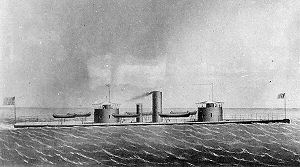 USS Monadnock, first of a two-ship class of 3295-ton
twin-turret monitors, was built at the Boston Navy Yard. Commissioned in
October 1864, she was sent to Norfolk, Virginia, to begin her Civil War
service. In December 1864 and January 1865, she used her four fifteen-inch
guns to support the two assaults that finally captured Fort Fisher, North
Carolina, thus closing the port of Wilmington to blockade running. After
Fort Fisher was taken, Monadnock went to Charleston, South
Carolina, to take part in final operations against that city and its
defenses. In April 1865, she served briefly on Virginia's James River,
then steamed south to Havana, Cuba, where she remained until June,
covering the Confederate ironclad Stonewall. USS Monadnock, first of a two-ship class of 3295-ton
twin-turret monitors, was built at the Boston Navy Yard. Commissioned in
October 1864, she was sent to Norfolk, Virginia, to begin her Civil War
service. In December 1864 and January 1865, she used her four fifteen-inch
guns to support the two assaults that finally captured Fort Fisher, North
Carolina, thus closing the port of Wilmington to blockade running. After
Fort Fisher was taken, Monadnock went to Charleston, South
Carolina, to take part in final operations against that city and its
defenses. In April 1865, she served briefly on Virginia's James River,
then steamed south to Havana, Cuba, where she remained until June,
covering the Confederate ironclad Stonewall.
After special outfitting at the Philadelphia Navy Yard, in October 1865 Monadnock began a long voyage to California, the longest cruise that a monitor-type warship had yet undertaken. After calling at several South American ports and passing through the Strait of Magellan, she arrived at San Francisco in June 1866 and was soon thereafter decommissioned at the Mare Island Navy Yard. In 1874 her wooden hull was broken up as part of a program to "rebuild" Civil War era monitors into modern ones. In fact, she was replaced by a completely new ship, which was also named Monadnock. USS Huron (1862-1869) Top USS Huron, a 691-ton Unadilla class screw steam
gunboat, was built at Boston, Massachusetts. Commissioned in January 1862,
she operated off South Carolina, Georgia and Florida for the next two
years, participating in the capture or destruction of three
blockade-running steamers and four sailing vessels. Huron also took
part in the several operations against Confederate shore positions, among
them bombardments of Fort McAllister, Georgia, and batteries in the Stono
River, S.C. USS Huron, a 691-ton Unadilla class screw steam
gunboat, was built at Boston, Massachusetts. Commissioned in January 1862,
she operated off South Carolina, Georgia and Florida for the next two
years, participating in the capture or destruction of three
blockade-running steamers and four sailing vessels. Huron also took
part in the several operations against Confederate shore positions, among
them bombardments of Fort McAllister, Georgia, and batteries in the Stono
River, S.C.
Transferred to the North Atlantic Blockading Squadron in 1864, Huron bombarded Fort Fisher, North Carolina, during both the unsuccessful attempt to capture that strong point in December 1864 and the successful one the next month. She subsequently participated in operations on the Cape Fear River, N.C. In May 1865, Huron steamed to the Gulf of Mexico to help with efforts to intercept escaping Confederate officials. Following the end of the Civil War, Huron served on the South American station. She decommissioned in October 1868 and was sold in June 1869. She subsequently became the merchant vessel D.H. Bills. USS Sassacus (1863-1868) Top USS Sassacus was built at the Portsmouth Navy Yard,
Kittery, Maine, as the first of a class of twenty-eight 974-ton
"Double-Ender" side-wheel steam gunboats. Commissioned in October 1863,
she spent several months undergoing repairs and then joined the blockade
off Wilmington, North Carolina. In February 1864, Sassacus was
involved in the destruction of two blockade runners, one after a long
chase. She began operations in the North Carolina Sounds in April 1864,
and on 5 May closely engaged the Confederate ironclad CSS
Albemarle. During this action,
Sassacus was badly damaged when she rammed the enemy ironclad,
which escaped essentially unhurt. Despite her damages, she remained on
duty in North Carolina and Virginia waters until September 1864, when she
could finally be released for refit. USS Sassacus was built at the Portsmouth Navy Yard,
Kittery, Maine, as the first of a class of twenty-eight 974-ton
"Double-Ender" side-wheel steam gunboats. Commissioned in October 1863,
she spent several months undergoing repairs and then joined the blockade
off Wilmington, North Carolina. In February 1864, Sassacus was
involved in the destruction of two blockade runners, one after a long
chase. She began operations in the North Carolina Sounds in April 1864,
and on 5 May closely engaged the Confederate ironclad CSS
Albemarle. During this action,
Sassacus was badly damaged when she rammed the enemy ironclad,
which escaped essentially unhurt. Despite her damages, she remained on
duty in North Carolina and Virginia waters until September 1864, when she
could finally be released for refit.
Sassacus returned to war service in November 1864 and took part in the two assaults on Fort Fisher, N.C., in December and January. She then operated on the rivers leading to Wilmington, N.C., and Richmond, Virginia, during the remaining months of the Civil War. Sassacus decommissioned in May 1865 and was sold in August 1868. USS Mackinaw (1864-1867) Top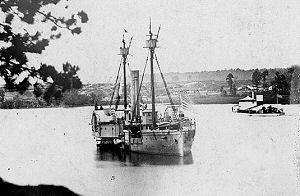 USS Mackinaw, an 1173-ton Sassacus class
side-wheel "double-ender" steam gunboat built at the New York Navy Yard,
was commissioned in April 1864. For much of that year, she served on the
James River, Virginia, taking part in engagements at Dutch Gap in August.
In early December, while on blockade duty, Mackinaw captured a
sailing blockade runner. Later in that month, and in January 1865, she
took part in ultimately successful assaults on Fort Fisher, North
Carolina. In February, the gunboat operated on the Cape Fear River, N.C. USS Mackinaw, an 1173-ton Sassacus class
side-wheel "double-ender" steam gunboat built at the New York Navy Yard,
was commissioned in April 1864. For much of that year, she served on the
James River, Virginia, taking part in engagements at Dutch Gap in August.
In early December, while on blockade duty, Mackinaw captured a
sailing blockade runner. Later in that month, and in January 1865, she
took part in ultimately successful assaults on Fort Fisher, North
Carolina. In February, the gunboat operated on the Cape Fear River, N.C.
Decommissioned in May 1865, as the war came to an end, Mackinaw returned to active service in January 1866. She spent more than a year with the North Atlantic Squadron and in the West Indies, but was decommissioned again in May and sold in October of 1867 USS Ticonderoga (1863-1887) TopTiconderoga went back into active service in 1866, after modifications to her rig, and was sent to European waters. She operated there, in the Mediterranean and off Africa until 1869, when she returned home for refit. In 1871-73, the ship served along South America's Atlantic coast, then spent much of 1874 with the North Atlantic Squadron. Out of commission from October 1874 until November 1878, Ticonderoga's next mission was an eastbound cruise around the World that lasted until she arrived at New York in August 1882. Decommissioned a month later, USS Ticonderoga had no further active service and was sold in August 1887. USS R.R. Cuyler (1861-1865) Top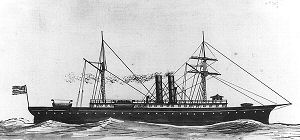 R.R. Cuyler, a 1202-ton (burden) wooden screw steamship,
was built at New York City in 1859-60. She was employed in trade between
New York, Cuba and New Orleans until the outbreak of the Civil War.
Chartered by the Navy for war service in May 1861 and purchased three
months later, in June R.R. Cuyler was sent to enforce the blockade
of Florida's west coast. Over the next three years, she was involved in
the capture of several blockade runners, both steamer and sailing types,
off Florida and elsewhere in the Gulf of Mexico. R.R. Cuyler, a 1202-ton (burden) wooden screw steamship,
was built at New York City in 1859-60. She was employed in trade between
New York, Cuba and New Orleans until the outbreak of the Civil War.
Chartered by the Navy for war service in May 1861 and purchased three
months later, in June R.R. Cuyler was sent to enforce the blockade
of Florida's west coast. Over the next three years, she was involved in
the capture of several blockade runners, both steamer and sailing types,
off Florida and elsewhere in the Gulf of Mexico.
In 1864, R.R. Cuyler's operating area was changed to the waters off the Confederacy's Atlantic coast. On 4 December of that year she assisted in the capture of the noted blockade runner Armstrong. In mid-January 1865 R.R. Cuyler took part in the successful assault on Fort Fisher, thus closing the port of Wilmington, North Carolina, to the blockade running trade. With the defeat of the Confederacy having eliminated the Navy's need for her services, R.R. Cuyler was decommissioned in July 1865 and sold in August. She returned to commercial service under the same name, but was sold to the Republic of Columbia in 1866 for addition to that nation's navy. Renamed El Rayo, on 12 September 1867 she was wrecked by a storm at Cartagena. USS Santiago de Cuba (1861-1865) Top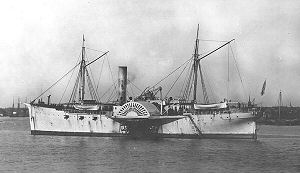 Santiago de Cuba, a 1567-ton (burden) wooden side-wheel
steamship, was built in 1856 at New York City for commercial use. She was
purchased by the U.S. Navy in September 1861, converted to a cruiser and
commissioned as USS Santiago de Cuba in November 1861. Sent to the
Gulf of Mexico area to enforce the blockade of the Confederate States and
protect American shipping, she proved to be a very successful blockader.
The first of her many captures was the schooner Victoria, taken in
early December. During 1862 and 1863, Santiago de Cuba mainly
operated in the western Atlantic, capturing several blockade runners,
among them the steamships Columbia
(on 3 August 1862), Victory (21 June 1863), Britannia (25
June 1863) and Lizzie (15 July 1863). For several months in 1862,
she also served with a special squadron organized to search for the
Confederate cruisers Alabama
and Florida. Santiago de Cuba, a 1567-ton (burden) wooden side-wheel
steamship, was built in 1856 at New York City for commercial use. She was
purchased by the U.S. Navy in September 1861, converted to a cruiser and
commissioned as USS Santiago de Cuba in November 1861. Sent to the
Gulf of Mexico area to enforce the blockade of the Confederate States and
protect American shipping, she proved to be a very successful blockader.
The first of her many captures was the schooner Victoria, taken in
early December. During 1862 and 1863, Santiago de Cuba mainly
operated in the western Atlantic, capturing several blockade runners,
among them the steamships Columbia
(on 3 August 1862), Victory (21 June 1863), Britannia (25
June 1863) and Lizzie (15 July 1863). For several months in 1862,
she also served with a special squadron organized to search for the
Confederate cruisers Alabama
and Florida.
Following an overhaul between December 1863 and June 1864, Santiago de Cuba rejoined the blockade. She captured the steamer Advance on 10 September 1864 and the steamer Lucy in early November. During December 1864 and January 1865 she participated in the two attacks that ultimately captured Fort Fisher, North Carolina, thus bringing to an end most Atlantic Coast blockade running. USS Santiago de Cuba was decommissioned in June 1865 and sold at auction in September. She soon reentered commercial employment and operated as a steamship for the next two decades. She was converted to a barge in 1886 and renamed Marion. The old ship finally passed out of service in about 1899. USS Maratanza (1862-1868) Top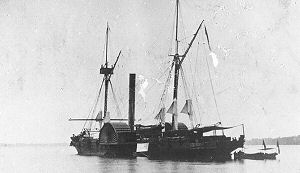 USS Maratanza, a 786-ton "double-ender" steam gunboat,
was built at the Boston Navy Yard, Massachusetts. Commissioned in April
1862, she served for the next five months in the James and York River area
of Virginia, supporting the operations of the Union army. She participated
in the capture of Yorktown in early May, bombarded enemy positions on
several occasions and took the Confederate gunboat
Teaser on 4 July. USS Maratanza, a 786-ton "double-ender" steam gunboat,
was built at the Boston Navy Yard, Massachusetts. Commissioned in April
1862, she served for the next five months in the James and York River area
of Virginia, supporting the operations of the Union army. She participated
in the capture of Yorktown in early May, bombarded enemy positions on
several occasions and took the Confederate gunboat
Teaser on 4 July.
Maratanza joined the blockading forces off Wilmington, North Carolina, in mid-September 1862 and continued to serve in that area until the Civil War ended. Her captures included two sailing blockade runners and steamers Stag and Charlotte. She also took part in the bombardments of Fort Fisher in December 1864 and January 1865 and of fortifications in the Cape Fear River in February 1865. USS Maratanza was decommissioned in June 1865 and was sold in August 1868. She subsequently served as a Haitian gunboat under the names Salnave and Union. |